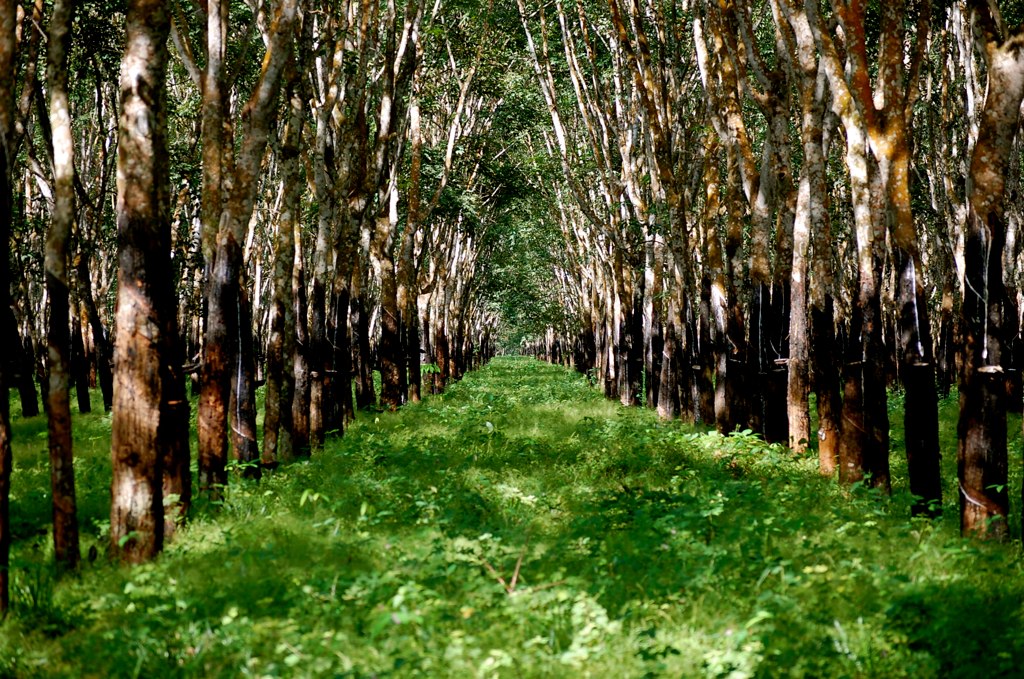កិច្ចការពារព្រៃឈើនៅកម្ពុជា គឺស្ថិតនៅក្រោមការទទួលខុសត្រូវសំខាន់របស់ក្រសួងកសិកម្ម រុក្ខាប្រមាញ់និង នេសាទ និងក្រសួងបរិស្ថាន។ យ៉ាងណាមិញ មានអង្គការមិនមែនរដ្ឋាភិបាលជាច្រើនដែលកំពុងធ្វើការនៅក្នុងផ្នែកនេះ ដែលក្នុងនោះមានដូចជា ភ្នាក់ងារអង្គការសហប្រជាជាតិ និងរួមទាំងស្ថាប័នអន្តរជាតិរហូតដល់អង្គការមិនមែនរដ្ឋាភិបាលក្នុងស្រុកដ៏ទៃទៀត។ គម្រោងសម្រាប់ការការពារព្រៃឈើជាច្រើន អាចនឹងត្រូវបានបែងចែកជា បីកម្រិតទៅតាមភាពចាំបាច់ និងសកម្មភាព រួមមាន៖ កម្រិតអន្តរជាតិ កម្រិតថ្នាក់ជាតិ និងថ្នាក់តំបន់។

ចម្ការដំណាំកៅស៊ូ នៅកម្ពុជា។ រូបភាព ថតដោយ Irayani Queencyputri។ អាជ្ញាប័ណ្ណ CC BY-NC 2.0.
កម្មវិធីអន្តរជាតិនានា និងការចូលរួមរបស់អង្គការមិនមែនរដ្ឋាភិបាល
កម្មវិធីអន្តរជាតិដ៏ធំបំផុតជាងគេ ត្រូវបានគាំទ្រដោយអង្គការសហប្រជាជាតិតាមរយៈកម្មវិធីគម្រោង រ៉េដបូក ដែលបានបកស្រាយក្នុងទំព័រការកាត់បន្ថយការប្រែប្រួលអាកាសធាតុ និង សហគមន៍ព្រៃឈើ។ គម្រោងនេះ បានប្រមូលផ្តុំអង្គការមិនមែនរដ្ឋាភិបាលជាច្រើន ដែលធ្វើការពាក់ព័ន្ធនឹងបេសកកម្មនេះ។ 1
អង្គការសមាគមអភិរក្សសត្វព្រៃ (WCS) គឺជាអង្គការសកលមួយ ហើយជាស្ថាប័នដែលចំណាស់ជាងគេ ដែលយកចិត្តទុកដាក់លើការងារសង្គ្រោះសត្វព្រៃ និងតំបន់ព្រៃទូទាំងពិភពលោក រួមទាំងប្រទេសកម្ពុជាផងដែរ។ តាមរយៈការលើកកម្ពស់ការអភិរក្ស ការអប់រំ និងការពង្រឹងសមត្ថភាព។ អង្គការសមាគមអភិរក្សសត្វព្រៃ (WCS) មានគោលបំណងដើម្បីផ្លាស់ប្តូរឥរិយាបទរបស់មនុស្សជាតិចំពោះធម្មជាតិ និងដើម្បីជួយដល់សត្វព្រៃ និងមនុស្សរស់នៅប្រកបដោយភាពសុខដុម។ 2 នៅក្នុងប្រទេសកម្ពុជា អង្គការសមាគមអភិរក្សសត្វព្រៃ កំពុងធ្វើការលើគម្រោងជាច្រើន នៅតំបន់ព្រៃសីម៉ា ទំនាបខាងជើង (នៅក្នុងខេត្តព្រះវិហារ ) និងបឹងទន្លេសាប។ 3
មជ្ឈមណ្ឌលសម្រាប់មនុស្ស និងព្រៃឈើ នៅកម្ពុជា (រីខូហ្វ) ធ្វើការជាមួយរដ្ឋបាលព្រៃឈើ រដ្ឋាភិបាលក្នុងស្រុក សហគមន៍ និងអង្គការក្រៅរដ្ឋាភិបាល ដើម្បីជួយបង្កើត តំបន់ព្រៃសហគមន៍។ ការចងក្រងសហគមន៍ព្រៃឈើ គឺត្រូវបានស្ថិតក្រោម កម្មវិធី ព្រៃឈើជាតិ ២០១០-២០២៩ (ក្រសួងកសិកម្ម)។ អង្គការរីខូហ្វ រួមចំណែកបង្កើតតំបន់សហគមន៍ព្រៃឈើ ប្រមាណពាក់កណ្តាលនៅក្នុងប្រទេសកម្ពុជា ដែលមានចំនួន ២៤៥ កន្លែងនៃខេត្តចំនួន ១៤។
កម្មវិធី រ៉េដបូក ក៏បានសហការជាមួយអង្គការ និងគម្រោងផ្សេងៗទៀត ដូចជា៖
- គម្រោងគាំទ្រព្រៃឈើ និងជីវៈចម្រុះ (ខែវិច្ឆិកា ២០១២ - កុម្ភៈ ២០១៨) ស្ថិតក្រោមការឧបត្ថម្ភ ដោយទីភ្នាក់ងារសហរដ្ឋអាមេរិកសំរាប់ការអភិវឌ្ឍអន្តរជាតិ (USAID) និងក្រោមការគ្រប់គ្រងដោយអង្គការ Winrock អន្តរជាតិ។ គម្រោងនេះ ផ្តល់ជំនួយដល់អង្គការដៃគូរដូចជា វិទ្យាស្ថានគ្រប់គ្រងបូព៌ាបញ្ចឹម (EWMI) មូលនិធិសត្វព្រៃពិភពលោក (WWF) និងអង្គការសមាគមអភិរក្សសត្វព្រៃ (WCS)។ គម្រោងនេះមានគោលបំណងការពារព្រៃឈើ ព្រមទាំងរក្សាតុល្យភាព កំណើនសេដ្ឋកិច្ចតាមរយៈការអនុវត្ត ការគ្រប់គ្រងព្រៃឈើដោយចេរភាព។ តំបន់គោលដៅនៃគម្រោងរួមមាន តំបន់ទំនាបខាងកើត និងតំបន់ទេសភាពព្រៃឡង់ ក៏ដូចជាតំបន់អភិរក្សព្រៃសីម៉ា តាមរយៈកម្មវិធីសិក្សាគណនេយ្យភាពកាបូនសហគមន៍ (Action Learning for Community Carbon Accounting program)។ គម្រោងនេះ ខុសពីគម្រោងកម្មវិធី “ការគ្រប់គ្រងព្រៃឈើប្រកបដោយនិរន្តភាព” របស់កម្មវិធីអភិវឌ្ឍន៍អង្គការសហប្រជាជាតិ (UNDP) ដែលចូលរួមឧបត្ថម្ភថវិកាដោយ ស្ថាប័នបរិស្ថានសាកល (Global Environment Facility)។
- អង្គការសត្វព្រៃ និងរុក្ខជាតិអន្តរជាតិ (FFI) បានបង្កើតឡើង ដើម្បីជួយដល់ប្រភេទសត្វ និងរុក្ខជាតិ និងប្រព័ន្ធអេកូឡូស៊ី ដែលរងការគំរាមកំហែង ព្រមទាំងជួយស្តារជីវភាព ជនក្រីក្រ និងជនដែលងាយរងគ្រោះ។ សកម្មភាពរបស់អង្គការនេះមាន ៤ សំខាន់ៗ៖ សុវត្ថិភាពស្បៀង ការអភិរក្សជីវៈចម្រុះ សមភាព និងសមធម៌ និងការត្រៀមបង្ការគ្រោះមហន្តរាយ ។
ជារួមកម្មវិធី រ៉េដបូក នៅកម្ពុជាផ្តល់ការគាំទ្រទាំងផ្នែកហិរញ្ញវត្ថុ និងបច្ចេកទេស ដល់អង្គការរដ្ឋាភិបាល និងអង្គការមិនមែនរដ្ឋាភិបាល ព្រមទាំងផ្តល់ជាជំនួយឥតសំណងបន្ត និងមូលនិធិនានាទៅដល់អង្គការក្នុងស្រុកមួយចំនួន និងកិច្ចផ្តួចផ្តើមតូចៗក្នុងតំបន់។
មានបណ្តាញធំៗ ២ ដែលគៀងគរអង្គការមិនមែនរដ្ឋាភិបាលនានា ដើម្បីធ្វើការតស៊ូមតិ សម្រាប់ការពារព្រៃឈើ។ អង្គការកម្មវិធីផ្លាស់ប្តូរបទពិសោធន៍អនុផលព្រៃឈើ (NTFP-EP) ដែលប្រមូលផ្តុំអង្គការមិនមែនរដ្ឋាភិបាលចំនួន ៦០ និងអង្គការសហគមន៍ជាច្រើនទៀតនៅតំបន់អាស៊ី ដែលផ្តោតលើការពង្រឹងសមត្ថភាព និងគ្រប់គ្រងធនធានធម្មជាតិ។
អង្គការមិនមែនរដ្ឋាភិបាលថ្នាក់ជាតិ
នៅកម្រិតថ្នាក់ជាតិ មិនសូវមានការលើកឡើងដោយអង្គការមិនមែនរដ្ឋាភិបាលប៉ុន្មាននោះទេ ដោយសារតែកិច្ចការពារនៅកម្រិតថ្នាក់ជាតិភាគច្រើន គឺស្ថិតក្រោមការទទួលខុសត្រូវរបស់រាជរដ្ឋាភិបាលកម្ពុជា។
វេទិកានៃអង្គការមិនមែនរដ្ឋាភិបាលស្តីពីកម្ពុជា គឺជាអង្គការដែលមានសមាជិកភាព បង្កើតឡើងនៅអំឡុងទស្សវត្សរ៍ឆ្នាំ ១៩៨០ ដែលស្ថាប័ននេះមានគោលដៅ និងបេសកម្ម ដើម្បីការចែករំលែកព័ត៌មាន ការពិភាក្សា និងការតស៊ូមតិ។ អង្គការនេះមានកម្មវិធី ៣ ដែលផ្តោតលើការការពារព្រៃឈើ ៖
- កម្មវិធីស្តីពីបញ្ហាការអភិវឌ្ឍ
- កម្មវិធីស្តីពីបរិស្ថាន
- កម្មវិធីស្តីពីដីធ្លី និងជីវភាព
គម្រោងនានានៅមូលដ្ឋាន និងអង្គការមិនមែនរដ្ឋាភិបាលក្នុងស្រុក
ក្រុមប្រឹក្សាអភិវឌ្ឍន៍កម្ពុជា ចេញរបាយការណ៍មួយ ជារៀងរាល់ឆ្នាំ ស្តីពីកម្មវិធីរបស់អង្គការមិនមែនរដ្ឋាភិបាលនៅកម្ពុជា។ តារាងខាងក្រោមបង្ហាញពី អង្គការដែលមានគោលបំណងចម្បង គឺការការពារព្រៃឈើ ៖
អង្គការ | ឈ្មោះគម្រោង | មូលនិធិ | កិច្ចព្រមព្រៀងសហប្រតិបត្តិការជាមួយក្រសួង | ទីតាំងនៃគម្រោង | រយៈពេលនៃគម្រោង |
មូលនិធិផ្ទាល់ខ្លួន | ក្រសួងកសិកម្ម រុក្ខាប្រមាញ់ និងនេសាទ | ស្រុកសៀមប៉ាង, ខេត្តស្ទឹងត្រែង | ០១ មករា ២០១១ - ៣១ ធ្នូ ២០១៥ | ||
ព្រៃការពារសៀមប៉ាង ឆ្ពោះទៅរកចក្ខុវិស័យសម្រាប់អភិរក្សជីវចម្រុះនៅក្នុងព្រៃស្ងួតនៃប្រទេសកម្ពុជា (ដំណាក់កាលទី ២) | មូលនិធិផ្ទាល់ខ្លួន | ក្រសួងកសិកម្ម រុក្ខាប្រមាញ់ និងនេសាទ | ស្រុកសៀមប៉ាង, ខេត្តស្ទឹងត្រែង | ០១ មករា ២០១៦ - ៣០ មិថុនា ២០១៩ | |
ក្រុមបរិស្ថានថាមពលកកើតឡើងវិញ និងសាមគ្គីភាព (GERES) | គាំទ្រមូលនិធិដោយអង្គការWinrock កម្ពុជា | ព័ត៌មានពុំអាចរកបាន | ស្រុកសណ្តាន់ និងស្រុកសន្ទុក,ខេត្តកំពង់ធំ | ០១ មករា ២០១៦ - ៣១ ធ្នូ ២០១៦ | |
អង្គការ Winrock កម្ពុជា | ជំនួយទ្វេភាគីរបស់សហរដ្ឋអាមេរិក | ព័ត៌មានពុំអាចរកបាន | ខេត្តកំពង់ធំ,ក្រចេះ, មណ្ឌលគិរី,ព្រះវិហារ, និងខេត្តស្ទឹងត្រែង | ០៩ វិច្ឆិកា ២០១២ - ៣១ ធ្នូ ២០១៧ | |
ការអភិរក្ស និងការគ្រប់គ្រងតំបន់ការពារទេសភាពទំនាបខាងជើង | ជំនួយទ្វេភាគីពីប្រទេសបារាំង, សហភាពអឺរ៉ុប, សហរដ្ឋអាមេរិក, និង ជប៉ុន ជំនួយពហុភាគីរបស់កម្មវិធីអភិវឌ្ឍន៍របស់អង្គការសហប្រជាជាតិ (UNDP) គាំទ្រមូលនិធិដោយអង្គការWinrock កម្ពុជា | ក្រសួងកសិកម្ម រុក្ខាប្រមាញ់ និងនេសាទ | ស្រុកស្វាយលើ, ខេត្តសៀមរាប និងខេត្តព្រះវិហារ | ០១ មករា ២០១២ - ៣១ ធ្នូ ២០១៧ | |
ជំនួយទ្វេភាគីពីប្រទេសបារាំង, សហភាពអឺរ៉ុប, ជប៉ុន, ដាណឺម៉ាក, និងសហរដ្ឋអាមេរិក ជំនួយពហុភាគីពីធនាគារអភិវឌ្ឍន៍អាស៊ី (ADB), កម្មវិធីអភិវឌ្ឍន៍អង្គការសហប្រជាជាតិ(UNDP), ធនាគារពិភពលោក, និងអង្គការស្បៀង និងកសិកម្ម (FAO) គាំទ្រមូលនិធិដោយអង្គការWinrock កម្ពុជា | ក្រសួងកសិកម្ម រុក្ខាប្រមាញ់ និងនេសាទ | ស្រុកស្នួល, ខេត្តក្រចេះ, ស្រុកកែវសីមា និងស្រុកអូររាំង ខេត្តមណ្ឌលគិរី | ០១ មករា ២០០៣ - ៣១ ធ្នូ ២០១៧ | ||
កម្មវិធីការពារតំបន់ព្រៃជួរភ្នំក្រវាញភាគខាងត្បូង | ជំនួយទ្វេភាគីពីសហរដ្ឋអាមេរិក | ក្រសួងកសិកម្ម រុក្ខាប្រមាញ់ និងនេសាទ | ខេត្តកំពង់ស្ពឺ, កោះកុង,ពោធិ៍សាត់, និងខេត្តព្រះសីហនុ | ០១ ធ្នូ ២០១៦ - ៣១ ធ្នូ ២០១៨ | |
ជំនួយទ្វេភាគីពីប្រទេសស៊ុយអែត, សហភាពអឺរ៉ុប, និងគាំទ្រមូលនិធិដោយអង្គការ Winrock កម្ពុជា | ព័ត៌មានពុំអាចរកបាន | ស្រុកកោះញែក, ពេជ្រាចិន្តា, និងសែនមនោរម្យ, ខេត្តមណ្ឌលគិរី | ០១ មករា ២០១៦ - ៣១ ធ្នូ ២០១៦ |
របាយការណ៍ឆ្នាំ ២០១៧ ស្តីពីទិន្នន័យអង្គការនៅកម្ពុជា របស់គណៈកម្មាធិការនីតិសម្បទា និងអភិវឌ្ឍន៍កម្ពុជា, ក្រុមប្រឹក្សាអភិវឌ្ឍន៍កម្ពុជា។ 4
អង្គការមិនមែនរដ្ឋាភិបាលជាច្រើនជួយគាំទ្រដល់សហគមន៍មូលដ្ឋាន និងបណ្តាញសហគមន៍ដូចជា សហគមន៍ព្រៃឡង់។ 5 ការជួយគាំទ្រទាំងនោះរួមមាន ការផ្តល់ចំណេះដឹង ការបណ្តុះបណ្តាល ជំនួយហិរញ្ញវត្ថុ ឬ/និងការតស៊ូមតិ។ ជាឧទាហរណ៍ គឺគម្រោងសិទ្ធព្រៃឈើ 6 ដែលជួយគាំទ្រដល់អង្គការមិនមែនរដ្ឋាភិបាល ដើម្បីកាត់បន្ថយនូវផលប៉ះពាល់អវិជ្ជមាននៃគម្រោងអភិវឌ្ឍន៍នានាដូចជា សម្បទានដីសេដ្ឋកិច្ច ជាដើម។
ភាគច្រើននៃអង្គការទាំងនេះធ្វើការក្នុងភាពជាដៃគូរ ជាមួយនឹងបណ្តាក្រសួងនៃរដ្ឋាភិបាលប្រទេសកម្ពុជា។ ទោះជាយ៉ាងណា ព្រៃឈើនៅកម្ពុជានៅតែជួបប្រឈមនឹងឧបសគ្គនៃការអភិរក្សដីធ្លី។ 7
ការរំពឹងទុក និងឧបសគ្គនាពេលអនាគត
អង្គការមិនមែនរដ្ឋាភិបាលនៅតែដើរតួសំខាន់ក្នុងការអនុវត្តផែនការជាតិ។ ដៃគូរជាច្រើនដែលបានកើតឡើងនៅកម្ពុជា តាមរយៈរវាងអាជ្ញាធរជាតិ និងមូលដ្ឋាន ព្រមទាំងអង្គការនានា គឺមានគោលបំណងដើម្បីពង្រឹងការការពារព្រៃឈើ។ 8 រចនាសម្ព័ន្ធនៃតំបន់ការពារ បានមានការចូលរួមកើនឡើងពីសំណាក់អង្គការមិនមែនរដ្ឋាភិបាលនៅក្នុងការអនុវត្ត។ តំបន់ដែលស្ថិតនៅក្រោមការការពារបានមានការកើនឡើងគួរឱ្យកត់សម្គាល់នាពេលថ្មីៗនេះ ជាពិសេសនៅក្នុងឆ្នាំ ២០១៦ ខណៈដែលរដ្ឋាភិបាលរៀបចំដីទំហំ ១លានហិកតា សម្រាប់តំបន់ការពារថ្មីៗ ដែលភាគច្រើននៅជុំវិញព្រៃឡង់។9
អនាគតនៃមូលនិធិរបស់អង្គការមិនមែនរដ្ឋាភិបាលទាំងនេះ នៅមិនទាន់មានភាពច្បាស់លាស់នោះទេ។ 10 ប្រសិនបើជំនួយអន្តរជាតិធ្លាក់ចុះនាពេលខាងមុខ អង្គការមិនមែនរដ្ឋាភិបាលជាច្រើននឹងរងការប៉ះពាល់យ៉ាងខ្លាំង ហើយកិច្ចការការពារព្រៃឈើក៏រងការប៉ះពាល់ដូចគ្នាដែរ។
បានធ្វើបច្ចុប្បន្នភាព៖ ២៧ ធ្នូ ២០១៧
ទាក់ទងនឹងអង្គការមិនមែនរដ្ឋាភិបាលទទួលបន្ទុកផ្នែកកិច្ចការពារព្រៃឈើ
ឯកសារយោង
- 1. រ៉េតបូកកម្ពុជា, ដៃគូរអង្គការនានា។ ចូលអាននៅថ្ងៃទី ២៥ កក្កដា ២០១៦។ http://www.cambodia-redd.org/
- 2. អង្គការសមាគមអភិរក្សសត្វព្រៃកម្ពុជា។ “ប្រវត្តិ និង បេសកម្មរបស់ អង្គការសមាគមអភិរក្សសត្វព្រៃ”។ ចូលអាននៅថ្ងៃទី ១១ សីហា ២០១៦។ http://cambodia.wcs.org/About-Us/History-Mission.aspx
- 3. អង្គការសមាគមអភិរក្សសត្វព្រៃ។ “ទីតាំងសង្គ្រោះសត្វព្រៃ៖ តំបន់ព្រៃឈើសីម៉ា ទំនាបខាងជើង និងបឹងទន្លេសាប និង តំបន់ព្រៃលិចទឹក”។ ចូលអាននៅថ្ងៃទី ១១ សីហា ២០១៦។ http://cambodia.wcs.org/Saving-Wildlife.aspx
- 4. ក្រុមប្រឹក្សាអភិវឌ្ឍន៍កម្ពុជា នៃគណៈកម្មាធិការនីតិសម្បទា និងអភិវឌ្ឍន៍កម្ពុជា, “ទិន្នន័យអង្គការនៅកម្ពុជា”។ របាយការណ៍ឆ្នាំ២០១៧។ ចូលអានថ្ងៃទី ២៨ ធ្នូ ២០១៧។ http://odacambodia.com/ngo/
- 5. វេទិកានៃអង្គការមិនមែនរដ្ឋាភិបាលស្តីពីកម្ពុជា។ កម្មវិធីដីធ្លី និងជីវភាព។ គម្រោងសិទ្ធព្រៃឈើ (២០១៣)។ “ករណីសិក្សា ការអភិវឌ្ឍតំបន់ព្រៃឡង់៖ តើពលរដ្ឋទទួលបានប្រយោជន៍ពីការអភិវឌ្ឍនេះឬទេ”។ ចូលអានថ្ងៃទី ២៥ កក្កដា ២០១៦។ https://preylang.net/wp-content/uploads/Other%20reports/Prey-Lang-Development-Case.pdf
- 6. វេទិកានៃអង្គការមិនមែនរដ្ឋាភិបាលស្តីពីកម្ពុជា។ កម្មវិធីដីធ្លី និងជីវភាព។ គម្រោងសិទ្ធព្រៃឈើ (២០១៣)។ ចូលអានថ្ងៃទី ២៥ កក្កដា ២០១៦។ http://www.ngoforum.org.kh/index.php/forestry-rights-project.
- 7. ផាក់ ស៊ាងលី។ “ព្រៃឈើនៅតំបន់អាស៊ីកើនឡើង លើកលែងតែកម្ពុជា៖ ការបកស្រាយរបស់អង្គការក្រៅរដ្ឋាភិបាល” ”។ ការសែតភ្នំពេញប៉ុស្តិ៍, ចុះថ្ងៃទី ២៥ វិច្ឆិកា ២០១៣។ ចូលអានថ្ងៃទី ២៥ កក្កដា ២០១៦។ http://www.phnompenhpost.com/national/asia%E2%80%99s-forests-grow-not-kingdom-ngo
- 8. គង់ មេត្តា។ “សំណើរគម្រោងព្រៃការពារទទួលបានការអនុញ្ញាតិហើយ”។ ការសែតភ្នំពេញប៉ុស្តិ៍, ចុះថ្ងៃទី ២២ មេសា ២០១៦។ ចូលអាន ១១ សីហា ២០១៦។ http://www.phnompenhpost.com/national/green-light-protected-forest-plans
- 9. ”អង្គការមិនមែនរដ្ឋាភិបាលគាំទ្ររាជរដ្ឋាភិបាលកម្ពុជាក្នុងការផ្តល់ដីទំហំជិតមួយលានហិកតាសម្រាប់តំបន់ការពារថ្មី”, អង្គការសមាគមអភិរក្សសត្វព្រៃនៅកម្ពុជា។ ចូលអានថ្ងៃទី ១១ សីហា ២០១៦។ http://programs.wcs.org/cambodia/About-Us/Latest-News/articleType/ArticleView/articleId/8893/NGOs-Support-Royal-Government-of-Cambodia-to-Designate-Almost-One-Million-Hectares-of-New-Protected-Areas.aspx
- 10. វង្ស សុខេង, Ananth Baliga។ “នាយករដ្ឋមន្ត្រី ហ៊ុន សែន សំដែងភាពមិនពេញចិត្តម្តងទៀតនឹងជំនួយអន្តរជាតិ”។ ការសែតភ្នំពេញប៉ុស្តិ៍ , ចុះថ្ងៃទី ៣០ មិថុនា ២០១៦។ ចូលអានថ្ងៃទី ២៥ កក្កដា ២០១៦។ http://www.phnompenhpost.com/national/pm-hun-sen-again-blasts-foreign-donors

